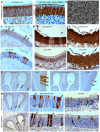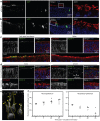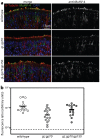A heparan-dependent herpesvirus targets the olfactory neuroepithelium for host entry
- PMID: 23133384
- PMCID: PMC3486907
- DOI: 10.1371/journal.ppat.1002986
A heparan-dependent herpesvirus targets the olfactory neuroepithelium for host entry
Abstract
Herpesviruses are ubiquitous pathogens that cause much disease. The difficulty of clearing their established infections makes host entry an important target for control. However, while herpesviruses have been studied extensively in vitro, how they cross differentiated mucus-covered epithelia in vivo is unclear. To establish general principles we tracked host entry by Murid Herpesvirus-4 (MuHV-4), a lymphotropic rhadinovirus related to the Kaposi's Sarcoma-associated Herpesvirus. Spontaneously acquired virions targeted the olfactory neuroepithelium. Like many herpesviruses, MuHV-4 binds to heparan sulfate (HS), and virions unable to bind HS showed poor host entry. While the respiratory epithelium expressed only basolateral HS and was bound poorly by incoming virions, the neuroepithelium also displayed HS on its apical neuronal cilia and was bound strongly. Incoming virions tracked down the neuronal cilia, and either infected neurons or reached the underlying microvilli of the adjacent glial (sustentacular) cells and infected them. Thus the olfactory neuroepithelium provides an important and complex site of HS-dependent herpesvirus uptake.
Conflict of interest statement
The authors have declared that no competing interests exist.
Figures










References
-
- Bagni R, Whitby D (2009) Kaposi's sarcoma-associated herpesvirus transmission and primary infection. Curr Opin HIV AIDS 4: 22–26. - PubMed
-
- Faulkner GC, Krajewski AS, Crawford DH (2000) The ins and outs of EBV infection. Trends Microbiol 8: 185–189. - PubMed
-
- Flaño E, Woodland DL, Blackman MA (2002) A mouse model for infectious mononucleosis. Immunol Res 25: 201–217. - PubMed
Publication types
MeSH terms
Substances
Grants and funding
LinkOut - more resources
Full Text Sources
Other Literature Sources

